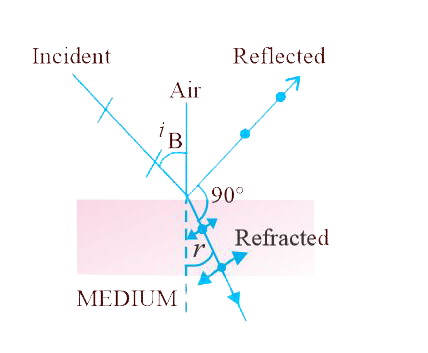Show using a proper diagram how unpolarised light can be linearly polarised by reflection from a transparent glass surface.
The diagram , showing polarisation by reflection is as shown . [Here the reflected and refreacted rays are at right angle to each other].
∴r=(π2−iB)
∴:μ=(sinissinr=tanis)
Thus light gets totally polarised by reflection when is is sincident at angle ls
( Brewster.s angle ) . where ia=tan−1μ

Topper's Solved these Questions
- 2018 QUESTION PAPER (DELHI ) BOOK - CBSE COMPLEMENTARY MATERIALCHAPTER - 2018 QUESTION PAPER (DELHI ) EXERCISE - SECTION E
15 Videos
- 2018 QUESTION PAPER (DELHI ) BOOK - CBSE COMPLEMENTARY MATERIALCHAPTER - 2018 QUESTION PAPER (DELHI ) EXERCISE - SECTION E
15 Videos
- CBSE BOARD EXAMNATION PAPER (2017 )BOOK - CBSE COMPLEMENTARY MATERIALCHAPTER - CBSE BOARD EXAMNATION PAPER (2017 )EXERCISE - SECTION E
12 Videos
Similar Questions
What is an unpolarised light ? Explain with the help of suitable ray diagram how an unpolarised light can be polarised by reflected from a transparent medium. Write the expression for Brewster angle in terms of the refractive index of denser medium.
View SolutionA beam of unpolarized light is incident on a glass air interface. Show, using a suitable ray diagram that light reflected from the interface is totally polarized by reflection from a transparent medium. Write expression for Brewster's angle.
View Solution
Knowledge Check
The angle of incidence at which reflected light is totally polarised for reflection from air to glass (refractive index n) is
Asin−1(n)Bsin−1(1n)Ctan−1(1n)Dtan−1(n)
how can one distinguish between an unpolarised light beam and a linearly polarised light beam using a polaroid ?
View SolutionDraw diagrams to show polarised and unpolarised light are represented in a ray diagram.
View Solution(a) How does an unpolarised light incident on a polaroid get polarised ? Describe briefly, with the help of a necessary diagram, the polarisation of light by reflection from a transparent medium.
(b) Two polaroids 'A' and 'B' are kept in crossed position. How should a third polaroid 'C' be placed between them so that the intensity of polarised light transmitted by polaroid B reduces to 1/8 th of the intensity of unpolarised light incident on A?
View Solution(a) (i) How does an unpolarised light incident on a polaroid get polarised ?
(ii) Describe briefly, with the help of a necessary diagram, the polarisation of light by reflection from a transparent medium.
(b) Two polaroids 'A' and 'B' are kept in crossed position. how should a third polaroid 'C' be placed between them so that the intensity of polarised light transmitted by polaroid B reduces to 1/8th of the intensity of unpolarised light incidennt on A?
View Solution(a) How does one demonstrate, using a suitable diagram, that unpolarised light when passed through a Polaroid gets polarised?
(b) A beam of unpolarised light is incident a glass-air interface. Show using a suitable ray diagram, that light reflected from the interface is totally polarised, when μ=taniB, when μ is the refractive index of glass with respect to air and iB, is the Brewster's angle.
View Solution(a) How does one demonstrate, using a suitable diagram, that unpolarised light when passed through a Polaroid gets polarised?
(b) A beam of unpolarised light is incident a glass-air interface. Show using a suitable ray diagram, that light reflected from the interface is totally polarised, when μ=taniB, when μ is the refractive index of glass with respect to air and iB, is the Brewster's angle.
View SolutionExplain the following giving reason for each:
(a) How does a polaroid work to produce a linearly polarised light from an unpolarised beam of light ?
(b) Why is it that light waves can be polarised but sound waves cannot be ?
(c) Why are sun goggles made of polaroids preferred over those using coloured glasses ?
View Solution
